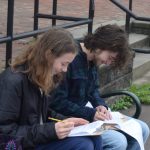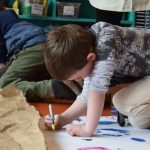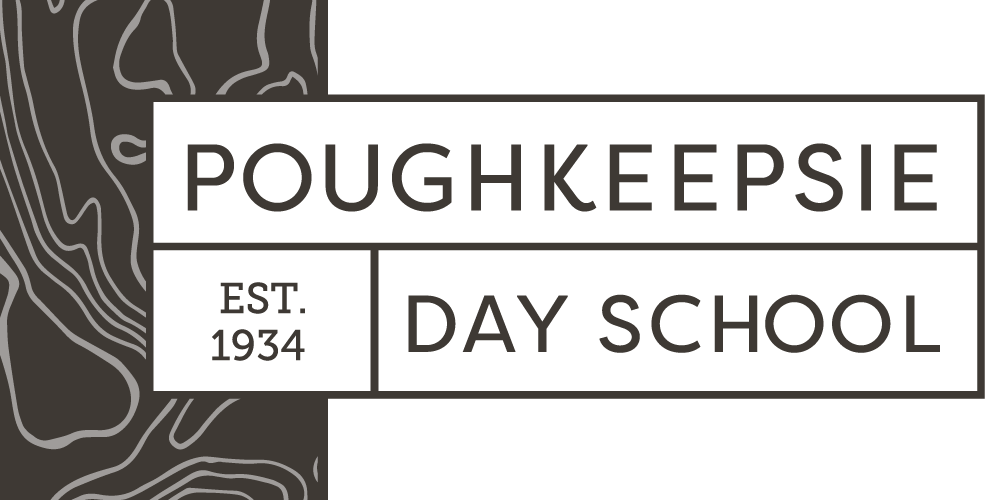Yes, students often do learn inside the box — if one thinks of the classroom as a “box.” In the high school this can mean anything from the wonderfully bright “Solarium” that abuts the Kenyon Student Center to the larger seminar spaces that once were the living spaces of the Kenyon family a century ago.
Learning also means leaving those boxes, and doing so regularly. Being at Poughkeepsie Day School means having the freedom to do this – sometimes close to the last minute: only a few hours ago, a teacher contacted me about an exhibit at the Mid-Hudson Heritage Center that coincides with the Spanish 3 curriculum. Could she take her class there tomorrow, she wondered? This sort of request is not unusual because teachers and students understand that one must seize the day at times – even if it is not particularly “convenient” and especially if it is messy and involves mud, water or paint. Witness the Ecology and Evolution students, who regularly slosh through the streams and ponds at Vassar College, and at times even fish in the Hudson for research purposes. Community Service, by definition, is a course all about leaving the school grounds. Recently, this class visited a wolf conservation organization to assist with cleaning and maintenance. Geology students really need to leave the classroom to learn. They travel often, and this is one reason this course runs in the fall and not in the spring, when winter weather can obstruct access to formations. Jonathan Heiles, describes a few recent trips:
We have gone to the outcrop behind Gilkeson, which is an Ordovician limestone. Then we went to outcrops of the same limestone on Cedar Valley Road and Cedar Avenue, taking measurements of the orientations of the bedding. From that we were able to roughly reconstruct how the limestone is folded and infer that it was deformed in a tectonic collision since it was deposited. Next we made three trips to the Austin Glen greywacke and shale at the Johnson-Iorio Park (right where the Mid-Hudson bridge ends in Highland). Here we worked out the depositional environment and the deformational history. The last class was at an outcrop on Noxon Road, where we saw evidence of three distinct periods of deformation and also indications of the tectonic setting in which the shales there formed.
On occasion, students trade one box, the classroom, for another, the theater. In mid-October, British Literature students attended a showing of Samuel Becket’s Happy Days at the Cocoon Theater. Upon returning to the classroom, they engaged in a discussion with visiting scholar, Dr. David Tucker, who came from Oxford to participate in the Becket Festival. As an expert in the staging of Becket, he visited PDS at the invitation of theater teacher, Josh Luckens, to talk with literature students and to give them a behind-the-scenes look at the production. And then there are those students who make “the boxes.” Recently, several students persisted over the course of many months to bring an athletic department dream to fruition. Finally, basketball fans will enjoy the new possession arrow “box,” thanks to Arthur H. (2016), David Held and others who helped out with soldering, programming and electrical work under the direction of Li Pipman Denaut.
These makers are joined by this year’s International Street Art students. Under the guidance of Wayne Toepp, they coated the theater prop shed with “interesting” tableclothes, which they then layered with graffiti. This activity was a follow-up to their construction in yellow masking tape of a sidewalk of “boxes” linking the loading dock entrance of Kenyon to the actual Gilkeson sidewalk. This whimsical “sidewalk” is now past its prime due to a few rainy days. Still, it remains a testament to the creative expression of students who think “outside the box.”





